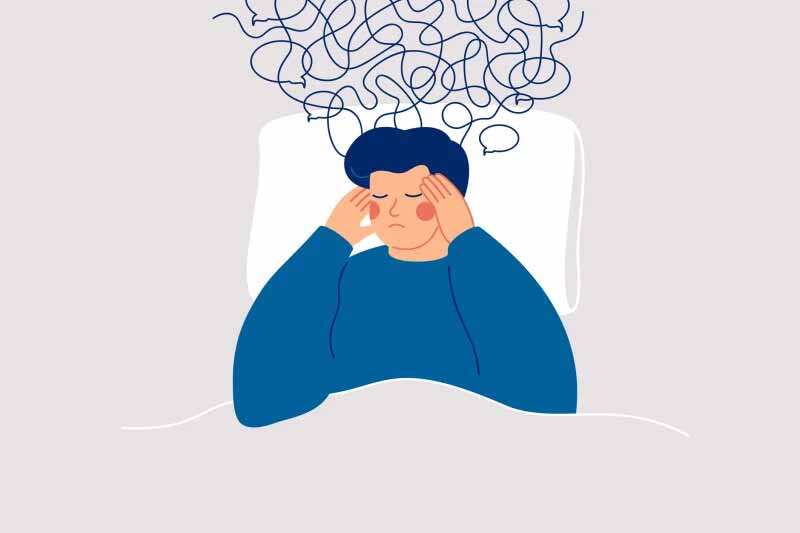
On average, people have about 6,200 thoughts each day. Inevitably, some will be unwanted, alarming, or just plain strange.
You know the kind: You’re driving down the freeway and suddenly visualize yanking the steering wheel to the left and careening into a ravine. Or you’re admiring the crashing waves beneath you—and, out of the blue, imagine pushing your partner off the cliff.
Both are examples of intrusive thoughts, and while they might feel upsetting when they strike, most of the time, they’re perfectly normal. “We all have these thoughts, and for the most part, we don’t really do anything with them,” says Jon Abramowitz, a professor of psychology at the University of North Carolina at Chapel Hill. “We just kind of say, ‘Oh, that’s a doozy. I don’t want to do that, and I’m probably not going to do it,’ and the thought ends up being like a brain fart—like mental noise.”
For some people, though, these thoughts linger and become debilitating. That’s largely omitted from conversations on social-media platforms like TikTok, where the “ha-ha” versions of intrusive thoughts are trending: In one video labeled “my intrusive thoughts won,” a woman slowly tastes a piece of confetti that rained down on her during a concert. In another, a man impulsively presses the SOS button in his car, triggering an emergency call. While the millions of video views have helped shine a light on and even normalize something that can feel shameful, experts say social media posts don’t capture the full story.
“I don’t think there’s anything malevolent—people are having fun and pointing out interesting things,” says Ben Eckstein, a therapist in Durham, N.C., who specializes in treating OCD and anxiety disorders. “But there’s some lack of awareness of what actual intrusive thoughts are, and perhaps people have not picked the best term to describe what they’re doing.”
What Are Intrusive Thoughts, Really?
Mental-health experts define them as unwanted and repetitive thoughts, images, or urges, says Jessica Beadel, a clinical psychologist based in Ohio. Intrusive thoughts are typically violent, sexual, or blasphemous. “It can be anything that a person finds repugnant or incongruent with their values and beliefs,” she says.
That makes them different from what’s commonly portrayed on TikTok: A quick thought about whether you should jump on stage as your favorite band plays probably won’t occur again, and likely won’t cause too much distress—unless you deeply value rule-following and are worried about what the idea says about you.
Some research suggests that lack of sleep, stress, and anxiety can increase the frequency of intrusive thoughts. Often, however, they appear spontaneously: someone might be holding a baby and suddenly imagine dropping him, Beadel says. Or, they might be hanging out on the balcony when they abruptly think about jumping over it. The thought could also center on having sex with a family member, encountering dangerous germs, or doing something embarrassing in front of a lot of people.
Many TikTok videos about intrusive thoughts make it seem like people have no choice but to give in to them, as though they’re commands. But the idea that these thoughts are linked with behavior is a big misconception, Beadel notes. “The reality is that our intrusive thoughts alone can’t compel us to engage in a behavior that we don’t want to do,” she says. “A true intrusive thought is simply a thought, and we can choose to act on it or not.” The majority of people do not—and these involuntary thoughts don’t capture their actual desires.
Still, some people become tormented by the possibility that their intrusive thoughts are true or will cause them to act in a certain way, and might begin performing compulsions in order to rid themselves of these thoughts—or alter their lives and routines entirely. Some people with obsessive-compulsive disorder (OCD), in particular, tend to experience intrusive thoughts more intensely than others and have a harder time shaking them off. They don’t regard them as passing notions—they take them literally. Say you’re driving down the road and suddenly wonder what would happen if you steered your car into a tree. Most people would allow the thought to dissipate as quickly as it formed, but a person with OCD might assume it means they’re dangerous and shouldn’t drive, Abramowitz says.
Such concerns often afflict new parents, who might experience the intrusive thought that they could harm or inappropriately touch their baby—and then refuse to change the child’s diaper or otherwise interact with him. That could jeopardize the person’s relationship with their child, while also making things more difficult for their partner, who’s suddenly tasked with handling all baby-related duties. They “get stuck in a tug-of-war with their intrusive thoughts,” Abramowitz says. “And that’s a game you cannot win, because our thoughts are ubiquitous. As soon as we try to stop having them, we think about them more.”
How They’re Treated
If intrusive or impulsive thoughts are causing a great deal of distress or interfering with your ability to function, it’s time to seek help. A mental-health professional can determine if they’re benign or if something more serious is going on, says Dr. Sue Varma, a psychiatrist in New York. It’s possible you could be dealing with OCD, a mood disorder, postpartum depression, anxiety, or post-traumatic stress disorder.
Research suggests that cognitive behavioral therapy (CBT) is the most effective treatment option for intrusive thoughts, Eckstein says. One common technique—exposure and response prevention—involves confronting these thoughts and allowing them to occur without feeling the need to perform a compulsive behavior. “It’s all about learning to relate to these thoughts differently,” Eckstein says. “We want to get to a place where we’re essentially saying, ‘Hey, a thought is a thought.’ A thought of ‘What if I’m a serial killer?’ is no different than a thought of ‘What if I’m a banana?’”
A majority of clients respond well to treatment and learn that their disturbing thoughts are actually safe and manageable, he says. That can happen within eight to 10 weeks—and many people report a “pretty steep reduction” in intrusive thoughts after about two weeks. “There is no world in which we’re never going to have these thoughts,” Eckstein says. “But there is a world in which these thoughts aren’t impactful.”
Beadel encourages anyone struggling with intrusive thoughts to remember they’re not alone. Even though the TikTok trend doesn’t get things right all the time, it does help normalize confusing thoughts—which is significant, given that many of her clients believe there’s something wrong with them and are reluctant to disclose their experiences to others. Keep in mind that “most of the people you’re surrounded by have intrusive thoughts from time to time,” she says. “These are just thoughts—they’re not indicators of who you are as a person, what your values are, or what your beliefs are.”
Important Notice: This article was originally published at https://time.com by Angela Haupt where all credits are due.
Disclaimer
The watching, interacting, and participation of any kind with anything on this page does not constitute or initiate a doctor-patient relationship with Dr. Farrah™. None of the statements here have been evaluated by the Food and Drug Administration (FDA). The products of Dr. Farrah™ are not intended to diagnose, treat, cure, or prevent any disease. The information being provided should only be considered for education and entertainment purposes only. If you feel that anything you see or hear may be of value to you on this page or on any other medium of any kind associated with, showing, or quoting anything relating to Dr. Farrah™ in any way at any time, you are encouraged to and agree to consult with a licensed healthcare professional in your area to discuss it. If you feel that you’re having a healthcare emergency, seek medical attention immediately. The views expressed here are simply either the views and opinions of Dr. Farrah™ or others appearing and are protected under the first amendment.
Dr. Farrah™ is a highly experienced Licensed Medical Doctor certified in evidence-based clinical nutrition, not some enthusiast, formulator, or medium promoting the wild and unrestrained use of nutrition products for health issues without clinical experience and scientific evidence of therapeutic benefit. Dr. Farrah™ has personally and keenly studied everything she recommends, and more importantly, she’s closely observed the reactions and results in a clinical setting countless times over the course of her career involving the treatment of over 150,000 patients.
Dr. Farrah™ promotes evidence-based natural approaches to health, which means integrating her individual scientific and clinical expertise with the best available external clinical evidence from systematic research. By individual clinical expertise, I refer to the proficiency and judgment that individual clinicians acquire through clinical experience and clinical practice.
Dr. Farrah™ does not make any representation or warranties with respect to the accuracy, applicability, fitness, or completeness of any multimedia content provided. Dr. Farrah™ does not warrant the performance, effectiveness, or applicability of any sites listed, linked, or referenced to, in, or by any multimedia content.
To be clear, the multimedia content is not intended to be a substitute for professional medical advice, diagnosis, or treatment. Always seek the advice of your physician or other qualified health providers with any questions you may have regarding a medical condition. Never disregard professional medical advice or delay in seeking it because of something you have read or seen in any website, video, image, or media of any kind. Dr. Farrah™ hereby disclaims any and all liability to any party for any direct, indirect, implied, punitive, special, incidental, or other consequential damages arising directly or indirectly from any use of the content, which is provided as is, and without warranties.








